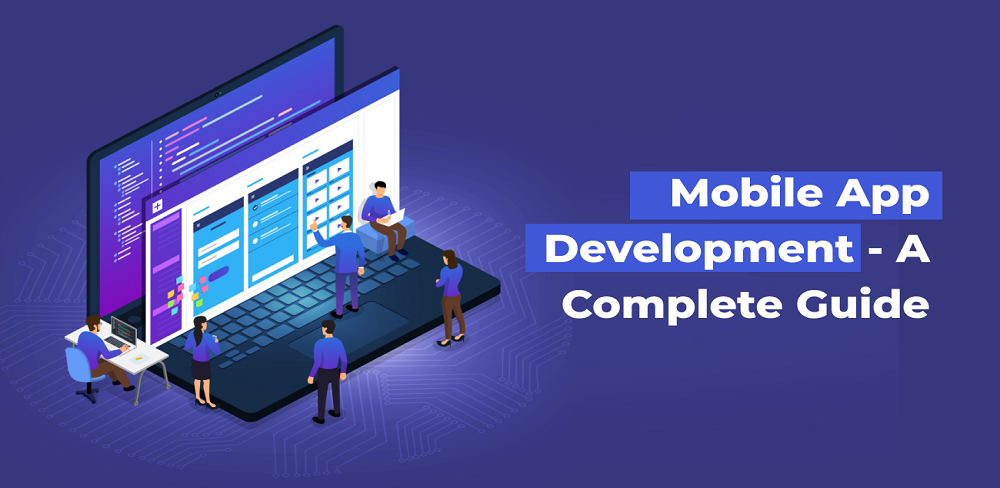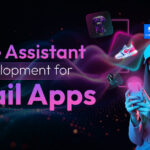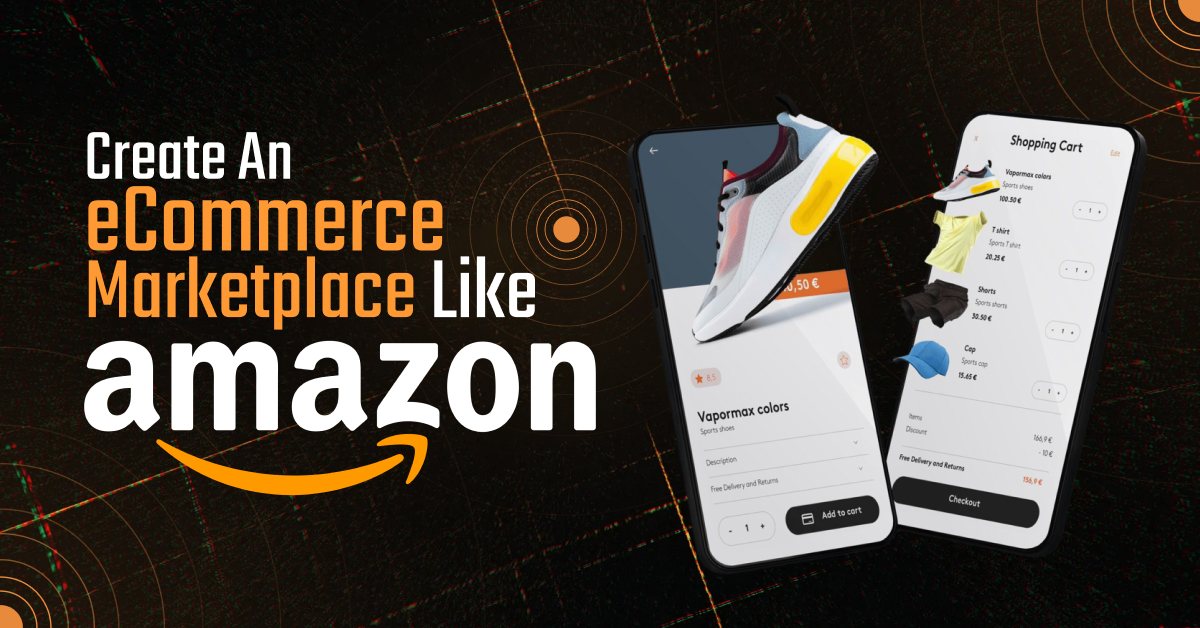Mobile application development is itself the most frequently coined term in any industry. Mobile app development is so persuasive for every industry that has hardly left any industry intact.
The mobile app development itself is going through a huge transformative phase. The software development industry is a hugely popular term, which can be called an umbrella term for web and mobile app development company.
With the advancement in technology and increased use of different mobile devices, the requirement of the app running on different platforms increased.
Mobile apps that started with the native platforms have now reached the same functioning apps regardless of the platform underneath. Few popular technologies such as Xamarin, React Native and others are taking cross-platform app development to next level.
This 2021 is bringing some curate thinking and some exciting strategic approaches for mobile app development dubai. This also reveals a number of opportunities for app development.
Mobile App Development Lifecycle
Today, there are around 4 billion mobile phone users around the world. The whopping high figures ensure the huge success of the Smartphone app industry. The addition of smartphones in millennials is also a top-class reason behind the rising figures.

- An average USA native checks his phone 120 times a day. This is such a surprising fact to check at.
- Mobile phone users prefer mobile over other digital media.
- 90% of the on-screen time is captured by mobile apps.
- Although cross-platform mobile apps are famous, still, 85 percent of consumers prefer native apps development over the cross-platform.
- In 2021, the mobile app revenue will raise by more than $693 million in 2021.
- An average smartphone user has more than 30 apps installed on his Smartphone.
The statistics are really interesting and motivating for app building company. The industry is growing and technology always rises for some good.
It sounds too beneficial, but still, app development demands a thorough strategy and understanding of mobile app development. Proper planning is required.
No app can crack the ground in a single entry. This is because; your app will compete with 1.5 million other apps in the play store and App store.
What is Mobile App Development?
Mobile app development is the process of building amazing mobile apps to be run on Smartphone devices. Every Smartphone has few apps, whether preinstalled or to be installed later.
Few apps are utility apps, which are important for the functioning of the phone. The app uses the network of the device for working remotely.
The mobile app development process requires creating software that can be installed on the device, utilizing backend services, and testing on the target platform.
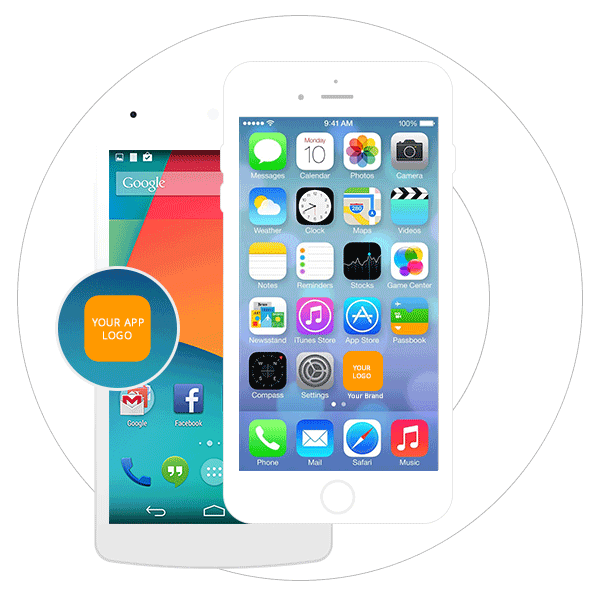
For developing the scalable mobile application, the IT development company needs to think of screen sizes, hardware details, and other aspects of the app development.
With the increasing number of jobs in the industry, it is important to have well-defined apps, which can make an impact on the user’s mind.
Alongside, when it comes to mobile app development with the help of mobile app development company in uae, the process of development also plays a great role. For startups, entrepreneurs and businesses, there is a big dilemma of choosing the right platform.
Mobile App Development Platform
IOS and Android are two of the most popular mobile development framework. iOS app development is proposed by Apple whereas Android is given by Google, which shares 80 percent of the Smartphone app market.

An android operating system runs over mobile devices developed by various manufacturers that developed using mobile development frameworks. While there are many similarities between the two platforms.
But, there are different software development kits, used for native app development. Apple uses iOS exclusively on devices manufactured by Apple, whereas Google has made Android available to other app building companies as well. This has really opened the market and pushed the development.
Mobile app development classification:
- Native mobile app development
- Cross-platform app development
- Hybrid app development
- Progressive web app development
Alternatives for Developing Mobile Apps
You can approach mobile app development in four different ways:
- Build Native Mobile Applications
- Build Cross-Platform Native Mobile Applications
- Build Hybrid Mobile Applications
- Build Progressive Web Applications
Comparison of App Development Alternatives
- Native Apps
- Cross-Platform Apps
- Hybrid Apps
- Progressive web Apps
App compatibility
- Native Apps– Native apps are developed with the help of platform-specific SDKs. These apps cannot be run on any other platform except the native one.
- Cross–platform Apps – Cross-platform app uses wrapping app development frameworks. These apps can be developed using any programming language and can run on any device. Example: React native app development
- Hybrid Apps – Hybrid app development is done with the use of the latest JavaScript, HTML5, and CSS mobile frameworks. These are then packaged for different platforms. Often hybrid apps are confused with the cross-platform app. These two are different.
- ProgressiveWeb apps – Progressive web apps are entirely different from native and cross. These are basically web app that can be embedded on the phone screen in form of icons. This app works inside the browser but behaves like a mobile app.
Run time
- Native Apps – Native apps offer the best runtime performance, being on the native platforms.
- Cross-platform Apps – Cross-platform app development is worked in such a way that makes it a little slower and can be shared with the single code base over different
- Hybrid Apps – The code is shared between mobile and web apps.
- Progressive web apps – Progressive web apps run on all available platforms including mobile and web.
Data operation
- Native Apps – The platform data can easily be used directly over native platforms.
- Cross-Platform Apps – Unified user experience for different platforms. The data used over one device requires little processing to be used on another device. If you want to hire ios developer, or hire android app developer, it is better to give a thought to this.
- Hybrid Apps – Works just similar to the web app.
- Progressive Web Apps – No need to install, the app working over the web can be embedded with an icon on the phone screen.
Cost
- Native Apps – The cost of native app development varies between both platforms.
- Cross-Platform Apps – Cross-platform costs higher due to the use of the latest technology. Also on average the app costs less. React native app development is a popular band that costs less than working out for separate native apps.
- Hybrid Apps – Cost is almost equal to native apps developed by a mobile app development company dubai. Web and mobile app development framework are used for development.
- ProgressiveWeb Apps – No cost of building an app as such for separate mobile-based development. The app runs on browser abilities. You can also consult with the app development companies in dubai about this.
Read More: MVP App Development
Why Choose Native App Development?
Native app development helps an app development company dubai leverage the potential of devices. The capabilities offered by the device such as GPS, Microphone, Camera work ultimately. This results in faster execution and builds a rich user experience.
Native apps run faster and give optimum performance. Push notifications are easier in implementation over native platforms. When the code is developed, there are fewer chances of bugs, because the code is compiled over native language.
Why Choose Cross-Platform App Development?
Android and iOS app development both have their own market. The market share of android app development is larger than iOS, but on another side, the iOS market is more revenue-generating on a particular customer.
In all, both platforms share a 50-50 partnership. Building the app separately for different platforms requires a huge budget. Most of the time, it is not possible to invest in complex apps on demand.
Developing the app for the native platform makes it harder to manage the business separately. Native apps offer amazing speed and functionality. You can also consult with the application development company in dubai.
If you wish to cut the budget and still want to communicate with customers using Android and iOS, a cross-platform app is for you. With advanced mobile app development frameworks and the best framework for app development such as react native, Xamarin, and others, it is possible to build a cross-platform app, that can save time, effort, and cost of mobile app development.
Why Choose Progressive Web App Development?
Progressive web apps are coded in different languages, such as JavaScript, HTML5, and styling. PWA development ensures that the apps are accessible through the browser.
PWA apps are suitable for devices with uninterrupted network access. These kinds of apps need neither to download nor publish on any plays store.

The app once stored on the phone, just like creating any shortcut on the desktop, gives access to the webserver. PWAs need not accommodate the native app development features such as machine learning abilities, camera, gyroscope, etc. So to build a prograssive web app, you must hire apps development companies in dubai who have expertise in that.
Now with the proper understanding of mobile app types, let’s take a look at the step-by-step process of app development dubai.
Mobile App Development Process
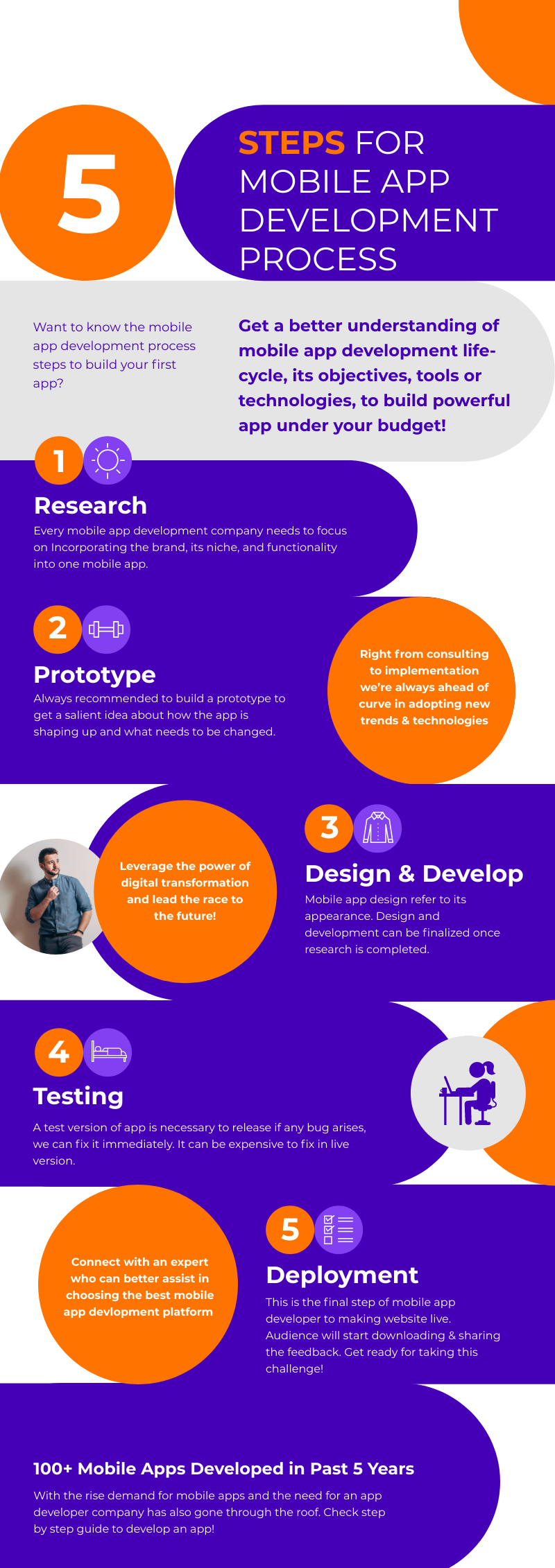
- Build an App Development Strategy
- Analyse and Plan your App Development
- Build UX/UI Design
- Begin App Development
- Testing the Developed App
1. Build an App Development Strategy
The first step of mobile app development is to build the app development strategy. What is your objective behind building the app? What problem do you wish to solve with the app? How do you wish to earn revenue through the app? What is your marketing idea with the app? How would you approach your end-users? Answering the question and preparing the questionnaire, will give you a clear idea about the next move with app development.
An app development company in dubai can give a quick start by determining the user persona. For instance, if you are developing a sports app, in this case, your user persona can be created using the user’s age, mobile usage, preferred sports, inclination, and the app engagement ratio.
Whereas for the eCommerce app, the user’s purchasing behavior can determine the next move and number of features for the app. Based on the preliminary app development strategy, you can go for a minimum viable product. The strategy is the key to app success. For the same, you need to procure the following steps.
Brainstorm the app idea
An app building starts with an idea. If you require an impressive list of features, you need to do some brainstorming work behind. Always start with the basic features and create a list over that.
Remember, you need not worry about fewer essential features for now. We can add them later with the needs arising. Sit together with the team and let all ideas come forefront. You can pick the best way to build mobile apps.
Research
Research is the most important part of development. Pre-development research defines the clear roadmap for the app, whereas post-development research builds the actual path. It is better to give way to the following questions.
- Know your target audience.
- How customers are going to use the app?
- Who are the existing competitors of your app?
- What is the USP of your app?
- What business model, your customers are following?
- Which stack are you going to use?
- What is your app budget?
- How many uses are paying for your type of mobile application?
- What is your budget?
- How long will it take to develop a mobile app?
Plan your MVP
Once you are done with the requirement gathering, it is advisable to pick all the functionalities you can include in the app. MVP is always built with the presenting features of the app, which can be the inaugural attempt for the app’s success.
Defining your MVP is an important task. This version of your app must contain all the relevant features for your customers. A good MVP tries to bind the users till the next version of the app comes. When you hire a company for your app development, first thing they will ask is how much should I charge for app development. So you need to communicate with them accordingly.
It can give you feedback for the app and let you develop a mobile app for a successful business. Cross-platform app development pushes you to be more conscious.
Below are the reasons, for which MVP is considered an important part:
- Test the product at an early stage
- Bring investors to your app
- Check what works in the market and what does not
- Launch the early product
- Faster product analysis
- Build a baseline for developing another app
- Test the ability to build and scale the app
Here are key elements of MVP
- MVP offers the desired straightforward functionalities to the user.
- Building the high-quality design
- Make the top production quality
- Make intuitive and refined usability experience
With a clear strategy, you focus on the app development idea. Building the app development strategy leverages the hidden potential and lets you analyze and plan the progress.
2. Analyze and Plan Mobile App Development
The strategy is the beginning point of all apps. Now once you have gone through the proper planning and strategy phase, it is easier to convert the vision into an achievable goal. Analysis and planning define the functionalities for the use case and creating the functional requirements.
This helps in building the roadmap. With proper planning, a mobile application development company can break the complete project strategy into different well-counted delivery milestones. A well-defined MVP product cuts down the cost and prepares for launch.
Also, the choice of platform is a must to consider. When you go for native app development, you have different mobile application development frameworks.
. Whether it is a cross-platform app, or hybrid app development, or a native app, you need to prepare the list of mobile app development frameworks, you want to use.
After listing out the mobile development framework, you can hire a mobile app developer for the same. Also, you need to think and decide on the final name of the product. Finding a perfect name is entirely correlated with your creativity.

Think of the app’s features, differentiate the name from your competitors and most importantly pick the market trends. Trending names easily gets on your tongue and easy to remember.
While deciding the name, you must keep app store optimization in mind. A relevant name to your powerful competitors gives you easy marketing.
Front end development
The front-end is actually meant to develop a mobile app that you see on your mobile/tablet screen. The mobile front-end is developed with the help of multiple mobile development frameworks.
Few apps require back-end and database interaction for front-end content, whereas others require only the designing part. For native applications, the latest progressive web app framework can be used.
iOS app development uses Objective-C, Swift, React Native, and Flutter whereas Android app development uses Java or Kotlin. Every P/L has its own advantage. You need to have a proper understanding of the code.
3. Build UI/UX design
How your app looks and how does it interact, really matters. The app user interface makes a great impression on the mind. Whether it is a full-fledged app or an MVP, UI plays an important role in keeping tying users. Mobile app design comprises two concepts:
- User Interface – Mobile applications must look neat and clean. PWA app development is easier this way due to the use of web technologies. A clutter-free app gives easy navigation of the app. UI design does mean creating an engaging interface that complements the user experience. When you hire developers, you must first ask them how much does it cost to create an app for the budget estimation. Designers use some basic principles such as structure principle, visibility principle, feedback principle, tolerance principle, reuse principle, and simplicity principle.
- User Experience – User Experience is the customer’s feelings about your product. A perfect app makes an emotional impact on the user. You must contact the mobile app development dubai to design the user interface. User Experience involves design, accessibility, usability, performance, HCI, ergonomics, and utility. With the increase in competition, user-centered design, and intuitive user experience started playing roles while developing mobile apps.
4. Begin App Development
Mobile app development has three integral components:
- Mobile Backend Server Technologies
- Application Programming Interface
- Frontend Development
Mobile App Backend Development
The external design and features of the app are called the front end, whereas the data handling and all operation is handles through the backend. Backend is the like the car engine, whereas the exterior is its frontend.
Developing the backend for mobile is an important part, which manages the signup, login, content management, cloud storage, and other functioning.
Backend focuses on business layer interaction, database logics, and architectural development, which make the application, live.
For simple applications, there is very little backend requirement. The simple app examples are calculator, compass, recorders, etc. Whereas famous apps such as Amazon, Facebook, or Netflix cannot run without a robust backend. Noticeably, Progressive web app development makes API handling easier and reduces the workload of backend development.
API development
Application Programming Interface (API) is the gateway, through which your app communicates with the server. There are very few apps, which work without a server connection, whereas a maximum of the apps requires server communication. Mobile apps are developed by developers in different languages.
Rest API is the popular word in mobile app development whether is native or hybrid app development. APIs help in connecting with the remote cloud server. There is a wide array of APIs available where most of them are Rest. REST API returns data in JSON format.
If you are a web development company and you have a development team, you can build Rest API whereas if you don’t have a team, you can go for purchasing the ready made one.
Common Architecture
While building API it is recommended to go with the common architecture. There are four types of architectures, Rest, Web Services, Event-driven, and hypermedia.
The most common type of API is Rest and Event-driven. It is always important to question the knowledge of developers about APIs while you hire an android app developer.
Documentation of Mobile API development
For letting others understand the API process, documentation is necessary. The clear API documentation allows you to see the history and documentation and the current state. This makes update easier. Also, for other developers, solid documentation of API is necessary.
Security
While interacting with the server through API, it is also necessary to keep security checks in mind. Security is a primary concern of every developer while he develops a mobile app.
Developers need to control mechanisms, secret keys, and privacy control before invoking web-based APIs. There are few API standards such as OAuth2, Open ID, and TLS to simplify the API integration.
5. Testing the Developed App
Post-development, the quality of the application needs to be scaled up. Quality Assurance is the crucial phase of mobile app development, where it decides the stability, reliability, and usability of the app. For ensuring stability and reduce the data leaking possibility, a developer needs to address multiple aspects.
Every app needs to go through many testing methods for becoming the perfect app. Progressive web app development needs less time in testing compared to native and cross. Some of the major testing methods that are used professionally are:
i. Functional Testing
In this testing technique, the app needs to justify all the use cases. Each user behaves differently and so is the usage of the app. So, it is important to ensure, that the app behaves perfectly in all test cases. Functional testing includes:
- Install and Initialize the app on all distribution channels
- Function testing and business feature testing
- Field, parameter, and user feedback testing
- Interruption testing
- Device usage testing
- Update testing on all distribution channels
ii. Performance Testing
An app needs to satisfy the purpose it is designed for. This performance is checked with performance testing. iPhone app development has very stringent expectations with the performance due to its market reputation. With this, you can check the consistency of the app performance in every condition regardless of the load.
- Performance testing under heavy data load
- App speed variation from normal to extreme load
- Stability testing in all condition
- Response testing
- Concurrency testing in case of multiple users
- Battery usage
iii. UX/UI Testing
It is ensured that the UI and UX are as per client needs. Native app development often makes it easy.User interface ensures the easy and smooth navigation of the user. UI testing is done to ensure that the final app matches the proposed design.
- Flow, easy navigation, visual interaction
- Design, fonts, consistency across the pages
- Color scheme, design, and look testing
- Navigation ambiguity and speed
iv. Documenting Testing
Documentation is the important part of the process, which mentions the requirements, layouts, specs, and client needs. If there is any mismatch between documentation and the developed process, then it can be a project failure.
- Test case and plan analysis
- Solve discrepancy
- Analysis of navigation flow, screen layout, etc.
- Design properness and requirement resemblance
There are several other types of tests, which are applicable overall iOS or android app development. Covering all of them in detail can make our discussion really longer.
- Security Testing
- Configuration Testing
- Platform Testing
- Recovery Testing
- Beta Testing
- Certification Testing
After testing, the app can be launched over the publishing platforms such as App Store or Play Store.
Conclusion
Mobile app development comprises a long process of development and testing with a number of iterations. A new version of the operating system is released every year.
Therefore your app needs to be compatible with all versions prevalent. No, any app is final, and it definitely requires a regular update. Fixing bugs also runs with the process and a system must coordinate with the user’s feedback.
Above we have discussed the mobile app development guide. With the proper insight, you can understand better, what is working and what’s not
